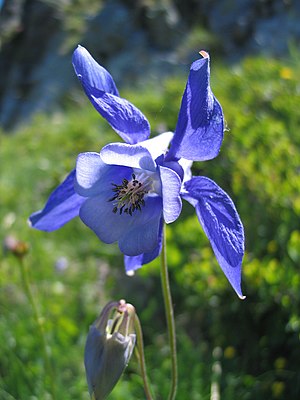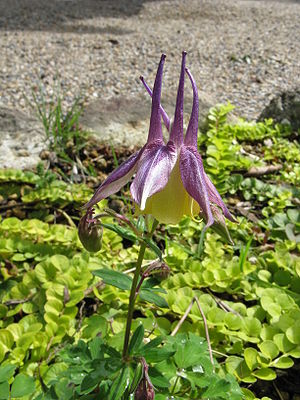Difference between revisions of "Aquilegia"
| Line 142: | Line 142: | ||
Image:Aquilegia 'Blue Butterflies' Flower 2671px.jpg|''Aquilegia'' hybrid cultivar 'Blue Butterflies' | Image:Aquilegia 'Blue Butterflies' Flower 2671px.jpg|''Aquilegia'' hybrid cultivar 'Blue Butterflies' | ||
Image:Wald-Akelei.JPG|[[Aquilegia vulgaris | Image:Wald-Akelei.JPG|[[Aquilegia vulgaris | ||
| + | File:Doubled flower of Aquilegia x hybrida 001.JPG|Double-flowered Aquilegia × hybrida | ||
</gallery> | </gallery> | ||
Revision as of 19:28, 19 January 2010
| Habit | herbaceous
| |
|---|---|---|
| Poisonous: | ☠ | yes, see text |
| Bloom: | ❀ | mid spring |
| Features: | ✓ | flowers, naturalizes, foliage |
|---|
If this plant info box on watering; zones; height; etc. is mostly empty you can click on the edit tab and fill in the blanks!
Colombine [1] is a genus of about 60-70 species of columbines, herbaceous perennial plants that are found in meadows, woodlands, and at higher altitudes throughout the Northern Hemisphere. They are known for their distinctive flowers, generally bell-shaped, with each petal modified into an elongated nectar spur. Its fruit takes the form of a follicle.[2] Columbine is derived from the Latin word for Dove.
Read about Aquilegia in the Standard Cyclopedia of Horticulture
|
|---|
|
Aquilegia (from aquilegus, water-drawer, not from aquila, eagle). Ranunculaceae. Columbine. Hardy perennial herbs of the northern hemisphere; grown for their profusion of showy flowers in early summer, and the delicate foliage later on in the year. Mostly with paniculate branches, terminated by showy fls., and 1-3 ternately-compound Lvs., commonly glaucous: the lfts. roundish and obtusely lobed: fls. large, showy, usually in spring or early summer; sepals 5, regular, petaloid; petals concave, produced backward between the sepals, forming a hollow spur; stamens numerous: fr. of about 5 many-seeded follicles. The columbines are among the most beautiful and popular of all hardy plants. The tall and strong-growing species can be used to advantage in half-shady positions. The attractive forms and rich variations in hue of aquilegias come out well when associated with hemerocallis, Siberian irises, thalictrums, polygonatums, Spiraea Filipendula and wild ferns. In the North, a similar effect is produced by grouping columbines together with white and blue Lupinus polyphyllus, Campanula persicifolia, Iris germanica and I. pattida var. dalmatica, Iceland poppies and trollius. For rockeries, the low-growing early alpine species, such as A. alpina, A. Stuartii and A.flabellata are well adapted. Throughout the middle and northern states, columbines need winter protection, dry leaves being preferable for covering. Seeds sown in pans, in coldframes in March, or open air in April, occasionally bloom the first season, but generally the second. The different species should be some distance apart, if possible, if pure seed is desired, as the most diverse species hybridize directly. They may be propagated by division of the roots in late fall, winter or early spring, but the better way is by seeds. Absolutely pure seed is hard to obtain except from the plants in the wild state; and some of the mixed forms are quite inferior to the true species from which they have come. A. caerulea, A. glandulosa, and A. vulgaris are likely to flower only two or three years, and should be treated as biennials; but A. vulgaris may be kept active for a longer period by transplanting. A light sandy soil, moist, with good drainage, sheltered, but exposed to sun, is what aquilegias prefer. Some of the stronger species, when of nearly full flowering size, may be transplanted into heavier garden soil, even heavy clay, and made to succeed; but for the rearing of young seedlings, a light, sandy loam is essential. The seed of most columbines is rather slow in germinating, and it is necessary to keep the soil moist on top of the ground until the young plants are up. A coldframe, with medium heavy cotton covering, is a good place to grow the plants. The cotton retains sufficient moisture to keep the soil moist on top, and still admits sufficient circulation of air to prevent damping-off of the young seedlings. When large enough, the seedlings may be pricked out into another frame for a time, or, by shading for a few days until they get a start, they may be set into the permanent border, or wherever they are to be placed.
|
The flowers of various species of Aquilegia were consumed in moderation by Native Americans as a condiment with other fresh greens, and are reported to be very sweet, and safe if consumed in small quantities. The plants seeds and roots are highly poisonous, and contain cardiogenic toxins which cause both severe gastroenteritis and heart palpitations if consumed as food.
Cultivation
| Aquilegia calendar? | ||
|---|---|---|
| January: | ||
| February: | ||
| March: | sow | |
| April: | transplant | |
| May: | flowering | |
| June: | flowering | |
| July: | ||
| August: | ||
| September: | divide | |
| October: | sow | |
| November: | ||
| December: | ||
| Notes: | ||
Large numbers of hybrids are now available for the garden, since the British A vulgaris was joined by other European and N American varieties. [3] Aquilegia species are very interfertile, and will self sow. [4]
Propagation
Pests and diseases
Species
Selected species: Columbine species include:[5]
- Aquilegia alpina L.
- Aquilegia atrata W.D.J.Koch – Dark Columbine
- Aquilegia atrovinosa
- Aquilegia aurea Janka
- Aquilegia barbaricina – Barbaricina Colombine (doubtfully valid)
- Aquilegia barnebyi – Oil Shale Columbine
- Aquilegia bernardii Gren. & Godr.
- Aquilegia bertolonii Schott
- Aquilegia blecicii Podobnik (doubtfully valid)
- Aquilegia brevistyla – Smallflower Columbine
- Aquilegia buergeriana
- Aquilegia caerulea – Colorado Blue Columbine
- Aquilegia canadensis – Canadian Columbine, Wild Columbine, "red columbine"
- Aquilegia champagnatii Moraldo, E.Nardi & la Valva (doubtfully valid)
- Aquilegia chrysantha – Golden Columbine
- Aquilegia desertorum – Desert Columbine
- Aquilegia desolatica – Desolation Columbine
- Aquilegia dinarica Beck
- Aquilegia ecalcarata
- Aquilegia einseleana F.W.Schultz
- Aquilegia elegantula – Western Red Columbine
- Aquilegia eximia – Van Houtte's Columbine
- Aquilegia flabellata – Fan Columbine, wodamakinari (Japanese) (including A. akitensis)
- Aquilegia flavescens – Yellow Columbine
- Aquilegia fragrans Benth. – Fragrant Columbine
- Aquilegia formosa – Crimson Columbine, Western Columbine, "red columbine"
- Aquilegia glandulosa
- Aquilegia grahamii – Graham's Columbine
- Aquilegia grata
- Aquilegia × hybrida
- Aquilegia incurvata
- Aquilegia japonica
- Aquilegia jonesii – Jones' Columbine
- Aquilegia karatavica
- Aquilegia karelini
- Aquilegia kitaibelii Schott
- Aquilegia lactiflora
- Aquilegia laramiensis – Laramie Columbine
- Aquilegia litardierei Briq.
- Aquilegia longissima – Longspur Columbine
- Aquilegia loriae – Lori's Columbine
- Aquilegia magellensis F.Conti & Soldano – Magella Columbine
- Aquilegia × maruyamana
- Aquilegia micrantha – Mancos Columbine
- Aquilegia moorcroftiana
- Aquilegia nigricans Baumg.
- Aquilegia nugorensis Arrigoni & E.Nardi (doubtfully valid)
- Aquilegia nuragica – Nuragica Columbine
- Aquilegia olympica
- Aquilegia ottonis Orph. ex Boiss.
- Aquilegia oxysepala
- Aquilegia pancicii Degen
- Aquilegia parviflora
- Aquilegia pubescens – Sierra Columbine, Coville's Columbine, sometimes misnomed "Yellow Columbine"
- Aquilegia pubiflora
- Aquilegia pyrenaica DC. – Pyrenean Columbine
- Aquilegia rockii
- Aquilegia saximontana – Rocky Mountain Columbine
- Aquilegia scopulorum – Blue Columbine, Utah Columbine
- Aquilegia shockleyi – Desert Columbine
- Aquilegia sibirica
- Aquilegia thalictrifolia Schott & Kotschy
- Aquilegia transsilvanica Schur
- Aquilegia triternata – Chiricahua Mountain Columbine
- Aquilegia turczaninovii
- Aquilegia viridiflora
- Aquilegia viscosa Gouan
- Aquilegia vitalii
- Aquilegia vulgaris – Common Columbine, European Columbine, Granny's Nightcap
- Aquilegia yabeana
Gallery
References
- ↑ Sunset Western Garden Book, 1995:606–607
- ↑ Dezhi & Robinson (2001)
- ↑ Andrew McIndoe, Kevin Hobbs: Perennials. David & Charles, 2005 ISBN 1558707646, 9781558707641
- ↑ New England Wild Flower Society Guide to Growing and Propagating Wildflowers of the United States and Canada
- ↑ Dezhi & Robinson (2001), RBGE [2008], USDA [2008]
- Standard Cyclopedia of Horticulture, by L. H. Bailey, MacMillan Co., 1963
External links
- w:Aquilegia. Some of the material on this page may be from Wikipedia, under the Creative Commons license.
- Aquilegia QR Code (Size 50, 100, 200, 500)











